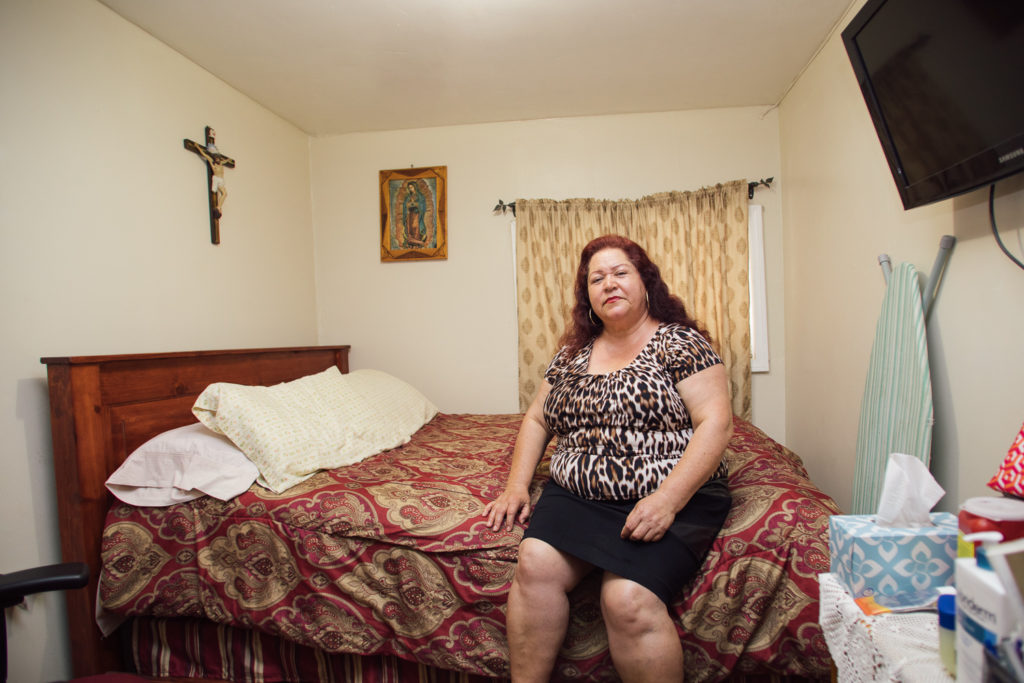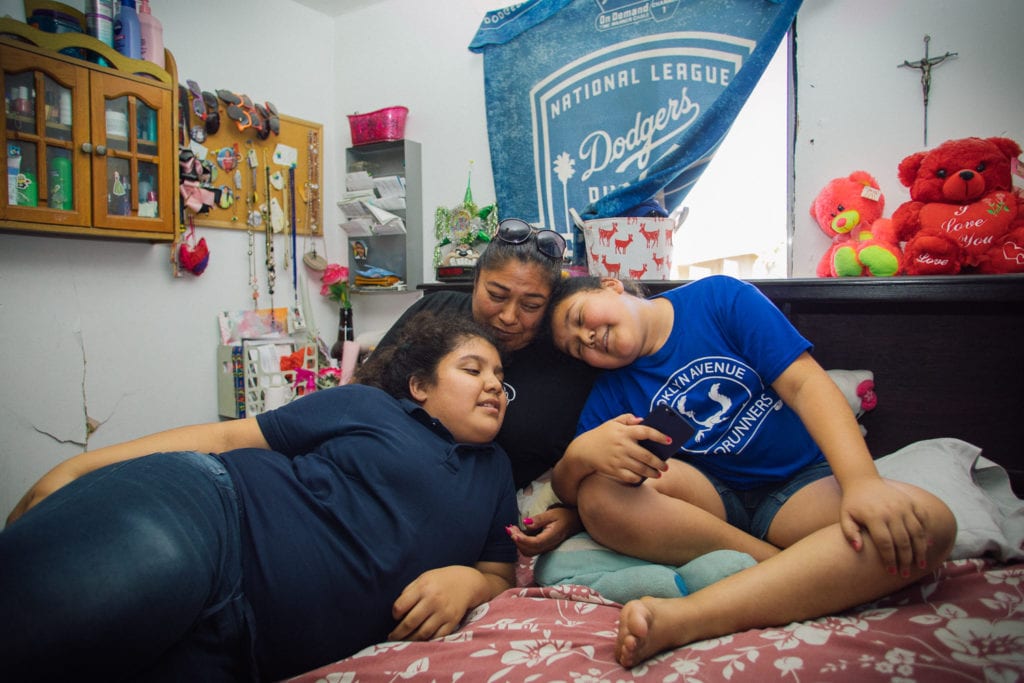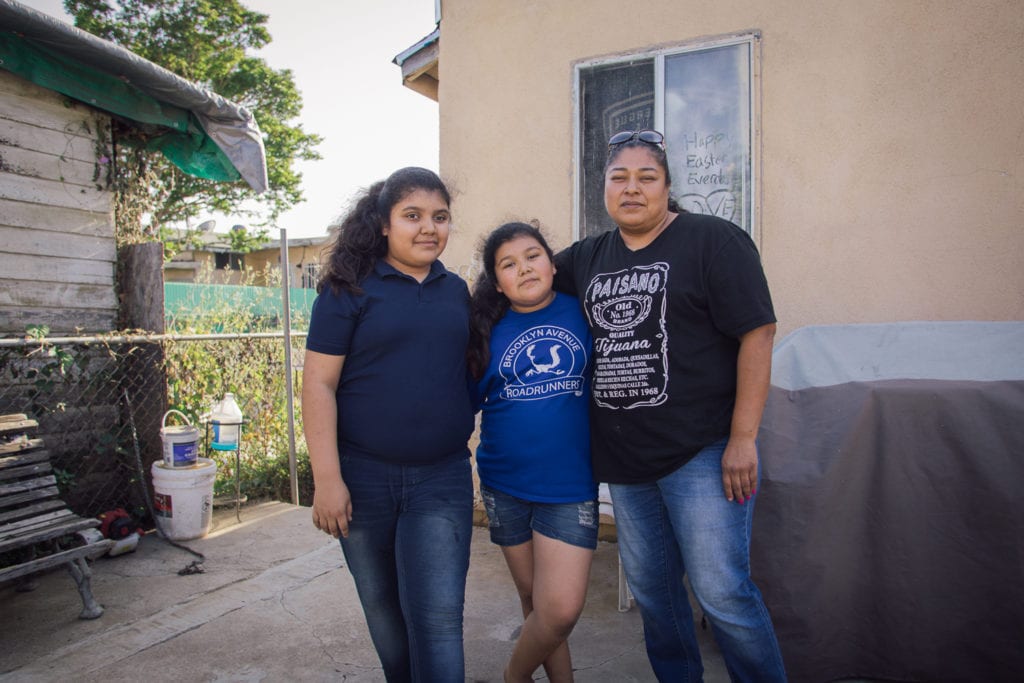Labor & Economy
Rent Law Offers Reprieve to Some of Los Angeles’ Most Vulnerable Families
But a county ordinance kicks in too late to help others.

Sandy Sampson tried to keep her battle with her landlord a secret from her two children. She and her husband spoke of the impending eviction only in Spanish. But soon her eldest daughter, Victoria, sensed what was happening and began to struggle in school.
Sampson said that Victoria, who is 11, worried that she would be separated from her grandmother, who lives in an attached unit, and wondered what would happen to their pit bull, Hercules.
Then, in March: some good news. They had beat back their eviction. Their family’s victory was due to Los Angeles County’s passage in September of a temporary rent control law that caps rent increases at three percent. The ordinance covers tenants residing in Sandy Sampson’s East Los Angeles neighborhood and other parts of unincorporated Los Angeles County.
Angelica Rosas, Victoria’s grandmother, has lived in her home for three decades and is diabetic. She said her health deteriorated as the landlord sought to nearly double her rent from $620 to $1,200. “For another house, I would need $3,000 [as a security deposit],” said Rosas, who is 57 and on disability. Rosas and Sampson were standing side by side in the elder woman’s cramped bedroom, the endpoint of a brief tour of their homes, “in-law units” that share a roof and wall.
After the landlord demanded the rent increase, they said, Rosas’ husband, who works in a clothing warehouse, began to make mistakes at work. Rosas contemplated subsisting on beans. “I told her, no, it’s no good,” said Sampson, a part-time driver for Amazon who sought legal assistance for the two families.
They were able to fend off the eviction “purely because of the rent control ordinance,” according to Gina Hong, an attorney with the Los Angeles Center for Community Law and Action, who represents the two women. “It’s a very classic scenario of a very effective application of the new law because their eviction notice was a no-cause eviction, in which you have 60 days to leave [the property].” The temporary law throws out no-cause evictions and requires landlords to show “just cause”—i.e., a reason, such as failure to pay rent—for evicting tenants.
Their landlord, Sergio Nunez, had purchased the homes from a man who inherited the property from his father, a longtime landlord who had kept rents very low but, Nunez says, neglected repairs. Nunez claims he sought to raise rents so he could upgrade the units and that he offered to let the families pay a monthly rent as low as $800 at one point. “They both told me that [they] just don’t want to live here,” said Nunez. He adds that he has good relations with a third tenant who occupies the unit in front and who has been able to absorb the $1,500 monthly rent payment, a more than doubling of what she paid previously.
* * *
In an apartment building nine miles away, in the densely populated Florence Firestone neighborhood, another group of tenants received eviction notices last year, but were not as fortunate. Their landlord, a limited partnership linked to the Gardena-based Swami International property management firm, served them with notices in April, too early for them to be covered by the county’s Interim Rent Control law.
Nearly a year later, a notice to vacate was affixed to the door of the minuscule studio apartment that Yulyzeth Hermenegildo shares with her husband, a truck driver, and their two small children. “My heart started to beat rapidly. I just knew this is it,” she said through an interpreter.
Later that day, she sat with her 2-year-old son on her lap watching a roomful of children, her mind filling with all that she had to do, including emptying out her apartment and checking with her sister to see if she could move in with her temporarily.
Like Sampson and Rosas, Hermenegildo and many of the East 61st Street tenants have actively campaigned for the passage of renter protections within the county. The Florence Firestone tenants, who live on East 61st Street, received eviction notices following complaints to the landlord about conditions in the building, according to Jose Nunez, a tenant activist. The property was infested with rats and roaches and had leaky plumbing and mold, according to a lawsuit filed by tenants last year.
Attorneys for Swami International did not respond to a request for comment.
Litigation involving the East 61st Street apartments is ongoing, but the first group of five tenants to go to trial last week failed to persuade the jury that the evictions violated the law, a much more difficult task in areas that lack rent control and just-cause protection.
The loss is taking a toll on the families, who are “completely priced out of the rental market for [studios]. They will end up homeless and/or couch-surfing for a significant amount of time,” according to Elena Popp, their attorney.
Landlord groups oppose rent control, saying it will curtail new housing development and force landlords out of the rental business. But tenant advocates consider it a necessary tool and argue that carefully crafted policies can help preserve scarce affordable housing and prevent people from falling into homelessness while still allowing a reasonable return for property owners and developers.
In the unincorporated communities of Los Angeles County, nearly a quarter of residents spend more than half of their income on housing costs. “Although we thought mental illness was the greatest driver of homelessness, that is no longer the case,” said Supervisor Sheila Kuehl, before she voted for the extension of the interim rent control measure on April 9. “It is now primarily economic.” For every five percent increase in rent, an estimated 2,000 people become homeless, according to a 2017 study from the real estate firm Zillow.
Hermenegildo, who previously paid $674 per month in rent, has secured a house to rent that she plans to share with three other families, but it will not be available for a few weeks. The rent on her new home is higher by almost 50 percent. She has had to tell her 5-year-old that he must leave his school down the street, along with his friends. “He asks me, Why?”
Emari Basto, a tax consultant who was being evicted from the East 61st Street apartments, was on her way to run errands and look at storage spaces with neighbors. She said it has been hard to find a place to rent. “[On] a lot of these [rental] applications, they ask if you have an eviction,” she said.
* * *
Sampson and Rosas are not in the clear yet. The county’s rent control ordinance expires in December. The Board of Supervisors is working to hammer out a permanent law. Of the more than 90,000 renter-occupied units in unincorporated Los Angeles County, only multifamily homes built before 1995 are covered by rent control, but the board voted to extend just-cause protection to single-family homes and new buildings in April, much to the consternation of landlord groups.
For now, Sampson is glad to be able to remain in her home, although she says there is mold in her daughters’ closet and electrical outlets in her kitchen that don’t work. On the tour of her home, Rosas points out broken linoleum and the soft flooring that she fears could signal foundation issues.
Such problems, according to Hong, their attorney, are all too common in Los Angeles. Rosas and Sampson filed a lawsuit against Sergio Nunez in Los Angeles Superior Court in January, alleging that he allowed unsafe and uninhabitable conditions and that he harassed them. Nunez, for his part, maintains that he dealt with the tenants in good faith and says his tenants have prevented him from gaining access to the units to make repairs. Nunez produced no evidence in the eviction trial that he had legally sought access to their units, according to Hong.
Nunez adds that he actually supports rent control and condemns the “outrageous” monthly rents as high as $1,800 on one-bedroom apartments in the area. His “really brand new” one-bedroom, one-bath rental units range in price from $1,200 per month to “fifteen hundred, tops,” he said. He sees himself keeping rents as low as possible.
Copyright Capital & Main

-

 Latest NewsDecember 10, 2025
Latest NewsDecember 10, 2025Capital & Main, L.A. Times Win Sidney Award for Reporting on Child Farmworkers
-

 Locked OutDecember 16, 2025
Locked OutDecember 16, 2025This Big L.A. Landlord Turned Away People Seeking Section 8 Housing
-

 Column - California UncoveredDecember 12, 2025
Column - California UncoveredDecember 12, 2025They Power the U.S. Economy, But Will Struggle to Afford Health Care
-

 The SlickDecember 19, 2025
The SlickDecember 19, 2025‘The Poor Are in a Very Bad State’: Climate Change Accelerates California’s Cost-of-Living Crisis
-

 Locked OutDecember 23, 2025
Locked OutDecember 23, 2025Section 8 Housing Assistance in Jeopardy From Proposed Cuts and Restrictions
-

 Column - State of InequalityDecember 11, 2025
Column - State of InequalityDecember 11, 2025A Little Place Called Home?
-

 Locked OutDecember 17, 2025
Locked OutDecember 17, 2025Credit History Remains an Obstacle for Section 8 Tenants, Despite Anti-Discrimination Law
-

 Latest NewsDecember 22, 2025
Latest NewsDecember 22, 2025Trump’s War on ICE-Fearing Catholics




